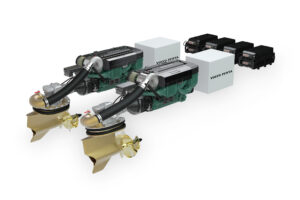
Arkema’s Elium is a liquid thermoplastic resin that can be used for building recyclable composite structures, including hulls, decks and spars. Conventional resins use styrenes that evaporate during curing, releasing volatile organic compounds and yielding long cross-linked chains, which makes them hard to recycle. Elium resin uses an acrylic monomer that releases small amounts of VOCs and doesn’t cross-link, making it recyclable multiple times.
“When you are talking about recycling, you have to prove it, so providing the resin is [one] thing, but identifying how you will recycle it is another challenge,” says Nicolas Valloir, Arkema’s business manager. The solution, he says, will likely involve government regulations enforcing recycling; however, Arkema is already creating case studies. Valloir cited a high-performance sailboat that Arkema built using recycled Elium resin. “This boat won a transatlantic race between Europe and Brazil,” he says, adding that—following chemical extraction—the recycled monomer was 99 percent pure.

Structures built using Elium can be recycled via a chemical-extraction process that removes the resin from its composite structure, or through a mechanical process where the chopped-up structure is turned into a thermoplastic that can be used for thermocompression bonding, injection molding or 3D printing.
Elium Upsides
Elium resin works with most boatbuilding materials—including fiberglass, carbon fiber and wood—and most gelcoats. Arkema doesn’t offer Elium resin for hand lay-up builds, but it can be used for infusion and light-resin transfer-molding processes. It reduces volatile organic compound emissions, increases recyclability, and lowers each build project’s overall carbon dioxide footprint.
Take the next step: arkema.com









